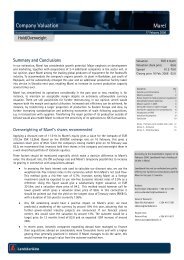Ársskýrsla Landsbankans - Landsbankinn
Ársskýrsla Landsbankans - Landsbankinn
Ársskýrsla Landsbankans - Landsbankinn
You also want an ePaper? Increase the reach of your titles
YUMPU automatically turns print PDFs into web optimized ePapers that Google loves.
Notes to the Consolidated Financial Statements<br />
52. Credit risk mitigation<br />
Non-derivative financial instruments<br />
Securing loans with collateral is the traditional method of mitigating credit risk. The Group applies the various instruments available towards<br />
reducing credit risk by obtaining collateral to secure client obligations where this is considered appropriate, normally in the form of a lien on client<br />
assets which gives the Group a claim on these assets for both existing and future client obligations.<br />
The amount and type of collateral required depends on an assessment of the credit risk associated with the counterparty. Guidelines are clarified by<br />
the Group regarding valuation parameters and the acceptability of different types of collateral. Credit extended by the Group may be secured on<br />
residential or commercial properties, land, securities, transport vessels, fishing vessels together with their non-transferable fishing quotas, aircraft,<br />
etc. The Group also secures its loans by means of receivables and operating assets, such as machinery, equipment, raw materials, and inventories.<br />
Residential mortgages involve the underlying residential property. Less stringent requirements are set for securing short-term personal loans, such as<br />
overdrafts and credit card borrowings.<br />
Where possible, management monitors the market value of collateral and may require additional collateral in accordance with the underlying loan<br />
agreement.<br />
The current discussion and political debate on possible changes to the fishing quota system in Iceland, which may include a gradual decrease in the<br />
quota awarded to current quota owners, may have an adverse effect on the value of the fishing vessels placed as security for a part of the corporate<br />
loan porftfolio of the Bank. This could therefore have an adverse effect on the value of the Bank‘s loan book. At the moment any such effect is<br />
impossible to determine.<br />
The Group is implementing a new collateral system for the Bank. The new collateral system is developed internally and allows the Bank to analyse the<br />
quality and value of the collateral held to secure the loan portfolio.<br />
In order to limit further the credit risk arising from financial instruments, the Group enters into netting agreements, which in cases of default<br />
arrange for the Group to be able to set off all contracts covered by the netting agreement against the debt. The arrangements generally include all<br />
market transactions between the Group and the client.<br />
Generally, collateral is not held over loans and advances to financial institutions, nor is it usually held against bonds and debt instruments.<br />
Derivative financial instruments<br />
In order to mitigate credit risk arising from derivatives the Group chooses the counterparties for derivatives trading based on stringent rules,<br />
accordingg to which clients must qualify q y as professional p clients but onlyy if certain conditions are met. The Groupp also enters into standard ISDA<br />
master netting agreements with foreign counterparties and similar general netting agreements with domestic counterparties.<br />
In addition, the Group has in place margin procedures for derivatives. The clients are required to hold a margin account with the Group where the<br />
collateral (i.e. cash or government bonds with rating at least BBB) is stored and managed. The client pledges the value of the margin account to the<br />
Group, thus reducing the risk of the Group should the client default. The margin system also defines that a client‘s collateral must be at least equal<br />
to the credit equivalent value of the derivative, which is the current potential cost of replacing the contract‘s expected net cash flows should the<br />
counterparty default.<br />
The Group issues a margin call if a client‘s collateral balance falls below the maintenance margin, which is defined as a percentage of the notional<br />
amount of the derivative and varies by type of derivative. In a margin call the Group demands that the client must bring additional collateral, usually<br />
within two days, in order to cover the losses. Otherwise the Group closes all or several contracts and takes possession of the collateral so that the<br />
collateral balance covers the credit equivalent value again.<br />
The Group‘s supervision system monitors derivatives exposure and collateral value intraday, it issues margin calls and manages netting agreements.<br />
NBI hf. Consolidated Financial Statements 2010 54<br />
All amounts are in ISK million<br />
154 Ársreikningur 2010 Allar upphæðir eru í milljónum króna



